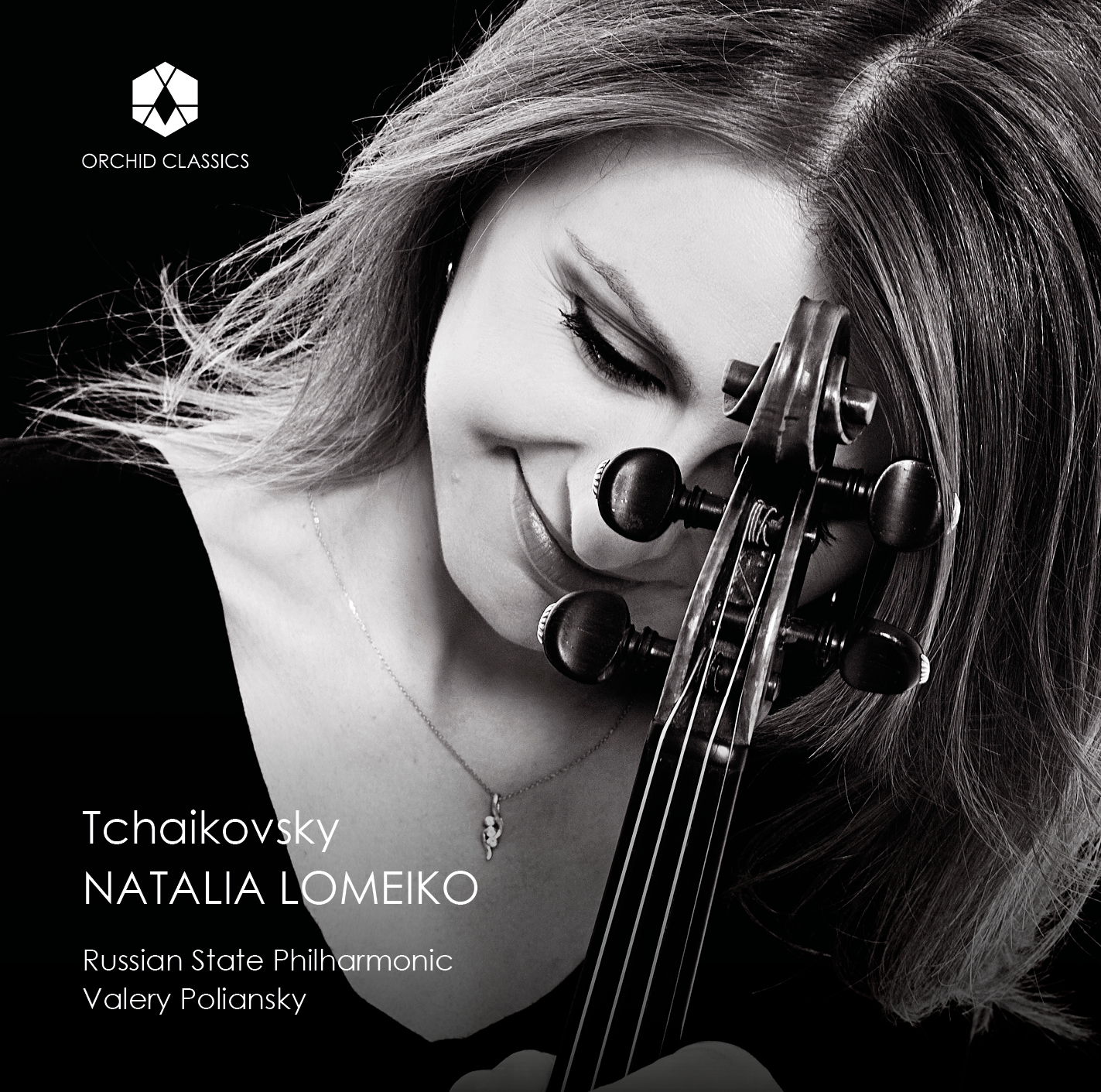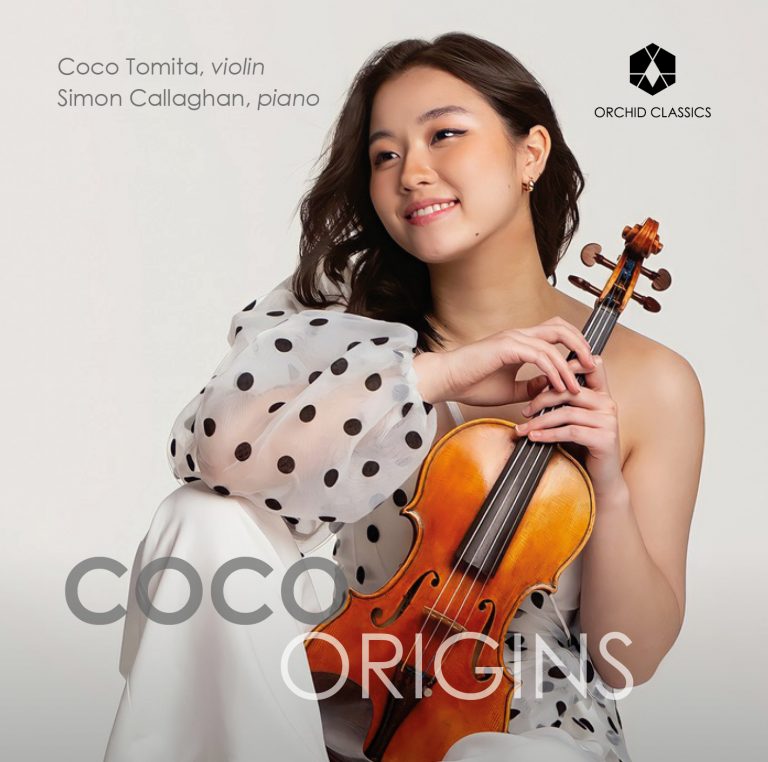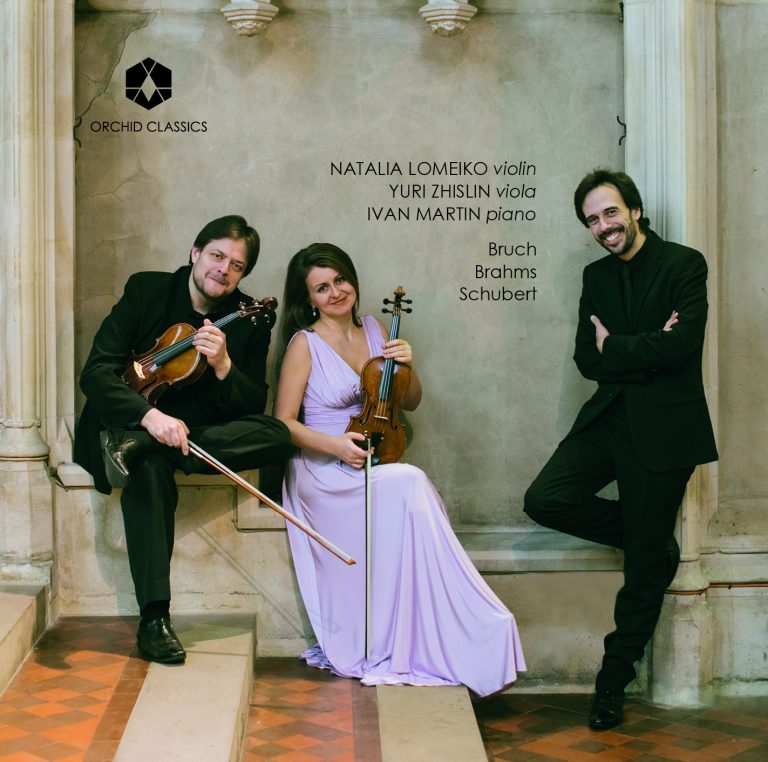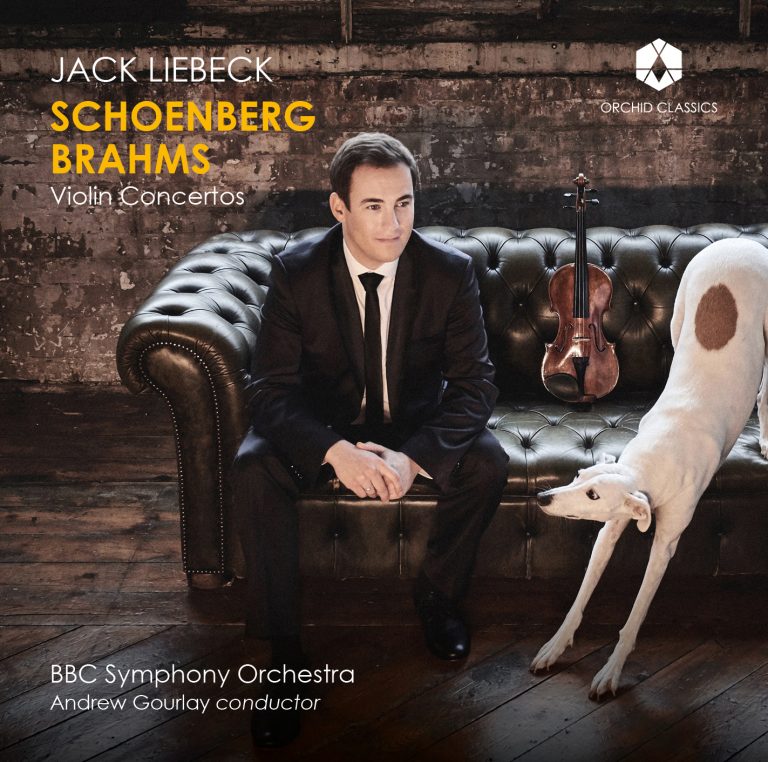Artist Led, Creatively Driven

Tchaikovsky
Natalia Lomeiko, violin
The Russian State Philharmonic
Valery Polyansky, conductor
Release Date: April 15th
ORC100195
Pyotr Ilyich Tchaikovsky (1840-1893)
Violin Concerto in D major, Op.35
1. I Allegro moderato
2. II Canzonetta
3. III Finale
Souvenir d’un lieu cher, Op.42
4. I Meditation
5. II Scherzo
6. III Melody
7. Sérénade mélancolique, Op.26
8. Valse-Scherzo, Op.34
Natalia Lomeiko, violin
The Russian State Philharmonic
Valery Polyansky, conductor
Tchaikovsky’s Violin Concerto, Op.35 of 1878 had a rather tumultuous journey from the work’s conception to the popularity it enjoys today. Tchaikovsky completed the first sketches very quickly while holidaying in the Swiss resort of Clarens on the shores of Lake Geneva. The intended dedicatee was the young violinist Iosif Kotek, a former student of Tchaikovsky’s at the Moscow Conservatory who was greatly admired by the composer; it is possible that they were conducting a clandestine relationship. Kotek also mediated between Tchaikovsky and Nadhezha von Meck, who would become his patroness and confidante, during the early stages of their acquaintance. He was not sufficiently well known to premiere the concerto, however, so Tchaikovsky approached Leopold Auer to be its dedicatee. Auer was sniffy, dismissing the piece as “unviolinistic” and only revising his opinion in the last year of the composer’s life. Eventually, Adolph Brodsky premiered the Violin Concerto in Vienna in 1881, but its early success was hindered when the influential critic Eduard Hanslick denounced it with considerable vehemence. Thankfully, it has outlived the criticism, and remains one of Tchaikovsky’s best-loved pieces.
Kotek played through segments of the concerto as it was written and may have inspired or influenced its composition. The first movement is based on two melodies that are explored and developed by both soloist and orchestra. The model of Mendelssohn’s Violin Concerto is also evident in the placing of the cadenza at the end of the central section before the main themes are reprised. The slow movement’s introduction delays the entrance of the main melody, which has all the more impact when it arrives. Its title, ‘Canzonetta’, means a type of vocal movement, highlighting the singing nature of the violin part. The finale begins with a long introduction after which the main melody fizzes along. This is contrasted with a reference to one of Tchaikovsky’s operas, Eugene Onegin; the oboe – used for the same purpose in the opera – plays a theme that evokes Tatyana, the opera’s tragic heroine. This does little to diminish the overall merriment of the finale, however; the violin writing is scintillating, and the work ends in high spirits.
The ‘Canzonetta’ was not Tchaikovsky’s first choice for the central movement of his Violin Concerto. While still at Clarens, in March 1878, he composed a ‘Méditation’ intended as the concerto’s slow movement, but on realising that it was too long in that context he set it aside and wrote the ‘Canzonetta’. The ‘Méditation’, reworked for violin and piano, became the first movement of the Souvenir d’un lieu cher (Memory of a dear place) – but it was not Clarens to which Tchaikovsky was paying tribute. He made a start on the work when back in Russia, in May 1878, before heading to his patroness Nadezhda von Meck’s Ukrainian country estate in Brailivo (or Brailovo, known today as Brailiv), finishing the work by the end of May and dedicating it to ‘B*******’ (almost certainly the place itself), making von Meck a present of the original manuscript. This is Tchaikovsky’s only known piece originally written for violin and piano (apart from the opening movement), but it has become well known in the version for violin and orchestra arranged by Alexander Glazunov. As with his more famous Souvenir de Florence for strings (1891-92), Tchaikovsky created a musical postcard or photo album as a means of remembering and celebrating a much-loved retreat.
The work opens with the ‘Méditation’, but anyone expecting something as dreamy as the 1894 piece of the same name by Massenet will soon find that Tchaikovsky’s interpretation of the word is not as a gentle reverie, but a complex train of thought. The violin’s poignant and impassioned material in the lower register is reprised after a gentler central section, but the coda features a subtle shift from D minor to D major during the violin line’s exquisite ascent into the ether. The Scherzo starts and ends with skittish, almost nervous energy framing a passage of sunny, song-like charm, and the ‘Mélodie’ is justly famous for its tender melody and sweetly nostalgic harmonies, concluding with a brief coda of irresistible tenderness.
Before Tchaikovsky and Auer fell out over the Violin Concerto, the violinist had inspired the composer to write another piece, the Sérénade mélancolique. In 1874 Tchaikovsky heard a public performance by Auer, which he praised in a review for its “great expressivity, the thoughtful finesse and poetry of the interpretation”. Both men attended a party given by Nikolai Rubinstein in January 1875, and it is possible that they discussed a new piece on that occasion – some accounts suggest that Auer commissioned the Sérénade from Tchaikovsky, others that he composed it off his own bat. Either way, in February Tchaikovsky wrote to his brother, Modest: “I have finished my Piano Concerto” – his first – “and have already written a violin piece I have promised to Auer”. But, as with the Violin Concerto, Auer did not give the work’s premiere – and, as with that concerto, it was Brodsky who did, in January 1876. Auer did however perform the work later the same year, during its first outing in St Petersburg.
The Sérénade begins with an atmospheric orchestral introduction, setting the scene for the violin’s first, folk-like entry, played entirely on the G string. A new theme unfolds, related to the woodwind opening, before an animated middle section that subsides into an introspective violin cadenza. The opening section is reprised, with a call-back to the very first bars during the coda, at the end of which the violin is given one last moment to reflect before the music fades into nothingness.
In the following year, 1877, Tchaikovsky built up to the writing of his Violin Concerto with another work composed for Kotek, the Valse-Scherzo. This time Kotek was the dedicatee, and his letters imply that he assisted with the work’s orchestration, although Tchaikovsky’s letters do not corroborate this. Nikolai Rubinstein conducted the piece’s premiere, which was given by one of Kotek’s fellow students at the Moscow Conservatory, Polish violinist Stanisław Barcewicz. The Valse-Scherzo was published in 1878 for violin and piano, an arrangement presumably considered more commercially viable by the publishing house; the orchestral version was not released until 1895, after Tchaikovsky’s death.
Tchaikovsky was particularly skilful at writing waltzes – his Symphony No.6 even includes a ‘limping’ waltz in 5/4 time – but this example reveals a different facet of his approach to the dance style, with less emphasis on swirling grace and more on the joyously unbuttoned nature of the violin writing, which has the folk-like freedom of gypsy music. There is a virtuosic central cadenza full of flashy display before the joie de vivre of the opening returns, punctuated by the orchestra’s witty woodwinds and popping pizzicato. The tragedy of Tchaikovsky’s life often casts a shadow over his music, but the Valse-Scherzo is a joy because for once there is not a cloud in sight, just blue sky, and sunshine.
© Joanna Wyld, 2022
Natalia Lomeiko
Violin
Born into a family of musicians in Novosibirsk, Russia, Natalia has established herself internationally as a versatile performing artist having won numerous prizes at the Tibor Varga, Tchaikovsky, Menuhin and Stradivari International Violin competitions. In the year 2000 she also received the Gold Medal and 1st Prize at the Premio Paganini International Violin Competition (Genoa, Italy), as well as 1st prize at the Michael Hill International Violin Competition (Auckland, New Zealand) in 2003.
Natalia studied at The Specialized Music School in Novosibirsk with Professor A. Gvozdev, at the Yehudi Menuhin School in England with Lord Menuhin and Professor N. Boyarskaya, and at the Royal College of Music and the Royal Academy of Music with Professor Hu Kun, where she currently lives in London.
Since her debut with the Novosibirsk Symphony Orchestra at the age of seven, Natalia has performed as a soloist with many orchestras, such as the Royal Philharmonic Orchestra under the baton of Lord Menuhin, the Philharmonia, Singapore Symphony, New Zealand Symphony, Auckland Philharmonia, Christchurch Symphony, Tokyo Royal Philharmonic, New European Strings, Moscow State Chamber, Melbourne Symphony, Adelaide Symphony, St Petersburg Radio Symphony, Nice Philharmonic, Russian State Philharmonic and Moscow Philharmonic Orchestras, amongst others.
Natalia has also collaborated with distinguished conductors such as the late Lord Menuhin, Lionel Bringuier, Werner Andreas Albert, Matthias Bamert, Arvo Volmer, Olari Elts, Sir William Southgate, Vladimir Verbitsky, Christian Knapp, Miguel Harth-Bedoya, Eckehard Stier, Mikhail Gerts, Valery Poliansky, Pavel Kogan, Yuri Simonov and Vladimir Ashkenazy.
In 2001 Natalia recorded Grieg’s three violin sonatas with pianist Olga Sitkovetsky for the DYNAMIC label to high critical acclaim, she gave a recital in Cremona on Paganini’s violin which was recorded live on FONE and released in 2003, and her CD of French sonatas with pianist Olga Sitkovetsky was released on Trust Records in 2004, of which the Strad described it as “… a stunning recital”. Natalia’s CD with husband violinist/violist Yuri Zhislin was released in 2011 on NAXOS, and her CD of Prokofiev’s music on ATOLL label was released in 2013 and met with 5-star reviews. In 2018 Natalia recorded the Mendelssohn Octet with Maxim Vengerov and soloists of the Oxford Philharmonic, and June 2019 saw a release of Trios by Brahms, Bruch and Schubert with Ivan Martin and Yuri Zhislin on the Orchid Classics label.
Natalia has performed extensively as a soloist and chamber musician in prestigious venues such as Carnegie Hall, Wigmore Hall, Purcell Room, Kings Place, Queen Elizabeth Hall, Buckingham Palace, the Barbican and Royal Festival Hall. She has performed chamber music with Maxim Vengerov, Gidon Kremer, Yuri Bashmet, the late Boris Pergamenschikov, Tabea Zimmerman, Dmitry Sitkovetsky, Schlomo Mintz, Daishin Kashimoto, Natalie Clein, Nicholas Daniel, Maxim Vengerov, Vadim Repin and Claudio Bohorquez, amongst others, and has appeared on numerous radio and TV broadcasts.
Natalia was appointed a Professor of Violin at the Royal College of Music in London in 2010 and at Eton College in 2017 and has appeared as guest concertmaster at the Royal Opera House, Berlin Philharmonic, London Symphony Orchestra, London Philharmonic Orchestra, BBC Symphony, Royal Philharmonic Orchestra, Berlin Radio Symphony, Oxford Philharmonic and Chamber Orchestra of Europe.
Valery Polyansky
Conductor
Valery Polyansky is a talented musician in many aspects, both of the highest culture and deep expertise. His charisma as a conductor is equally evident in the sphere of choral art, as well as at the control of the symphony orchestra, and creative searches are brilliantly implemented in a variety of genres: the operas, the works for the a cappella choir, monumental cantata and oratorical works, symphonies, and modern compositions.
Born in 1949 in Moscow, Polyansky graduated from the Moscow Conservatory (having studied under Evstolia Zvereva), followed by the Tchaikovsky Moscow State Conservatory, where he studied simultaneously in two departments: conductor and choir (class of Professor Boris Kulikov) and opera and symphony conducting (class of Odyssey Dimitriadi).
One of the most important milestones in the career of Polyansky was in 1971 when he founded the Chamber Choir of the Moscow Conservatory and became conductor of the Moscow Operetta Theatre. In 1975, in Italy, Polyansky and his Chamber Choir became winners at the largest international competition “Guido d’Arezzo” and for the first time, a choir from Russia received a gold medal in the nomination “academic singing”, having also received the “Golden Bell” prize – a symbol of the finest choir in the competition. In 1977, Polyansky, without leaving the choir, became conductor of the Bolshoi Theatre, where he participated together with G. Rozhdestvensky in the production of Shostakovich’s Katerina Izmailova, and lead other performances.
While leading the State Chamber Choir, Polyansky has performed alongside symphonic ensembles of Russia and has performed with orchestras of the Republic of Belarus, Iceland, Finland, Germany, Holland, the USA, Taiwan, and Turkey. He staged Tchaikovsky’s Eugene Onegin at the Gothenburg Musical Theatre (Sweden), and for several years he was the principal conductor of the opera nights festival in Gothenburg. Since 1992, Polyansky has been the artistic director and chief conductor of the State Academic Symphony Capella of Russia.
Polyansky has made approximately 100 recordings, both abroad and in Russia. Among them, the works by Tchaikovsky, Taneyev, Glazunov, Skryabin, Bruckner, Dvorak, Reger, Szymanowski, Prokofiev, Shostakovich and of particular note, Schnittke’s Symphony No.8, recorded on Сhandos Records in 2001.
The Russian State Philharmonic
The Russian State Philharmonic has had its own history since 1957. During the USSR period, the collective was led by Samuel Samosud, Yuri Aranovich, Maxim Shostakovich and Gennady Rozhdestvensky and all outstanding Russian conductors, such as Yevgeny Svetlanov, Nathan Rachlin, Neeme Jarvi and Vladimir Fedoseyev, performed with the orchestra. The first foreign tours were held in 1959 at the Festival of Youth and Students in Vienna. The orchestra has also conquered the USA, Canada, Germany, Spain, Great Britain, Greece, Japan and Taiwan, demonstrating its art in the best concert halls of the world such as Carnegie Hall and Lincoln Center (New York), Kennedy Center (Washington), Musikveren (Vienna), Gewandhaus (Leipzig), Jahrhunderthalle (Frankfurt), Barbican (London), Berlin Philharmonic Hall named after Karajan, and the halls of Tokyo, Taipei, Helsinki, Barcelona and Prague. Since 1991, the Symphony Orchestra has merged with the State Chamber Choir, and in 1992 Valery Polyansky became the artistic director and principal conductor of a new collective – the State Symphony Capella of Russia. All the Russian and Western classics of the 18th and 20th centuries, and modern music scores by A. Schnittke, S. Gubaidulina and A. Tchaikovsky amongst others, are in the repertoire of the Capella. The collective has a huge discography on the discs of the company “Melody”, Сhandos Records and Vista Vera.









